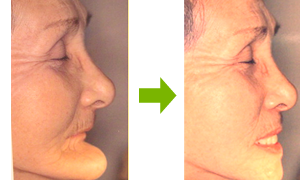2009年4月19日 « トップへ » 2009年4月21日
2009年4月20日
Can you eat anything with your current dentures?
Can you eat steak or firm bread with the full dentures you are using now? Can you eat anything you want with your current dentures?
 It is not so difficult to bite into hard foods, but it can be difficult eating foods that require some chewing.
It is not so difficult to bite into hard foods, but it can be difficult eating foods that require some chewing.
It is said that biting directly into foods that have a slight crunch, such as spring rolls and pies, or fruit with the skin on it, is very difficult with dentures. Some people find it difficult to bite into vegetables like lettuce.
Can you laugh or speak in a loud voice in front of people?
Many patients with full dentures worry about them falling out, have difficulty speaking clearly, and shy away from speaking in the presence of other people. This can have unfortunate consequences on their lifestyles.
Our clinic uses the 'maxillomandibular simultaneous impression method', a method modeled after Strack dentures developed in Germany, in order to provide our patients with the ability to eat what they want to eat, laugh with their mouths wide open, and perform other actions usually taken for granted.
"Full dentures made using the maxillomandibular simultaneous impression method"
The prototype used for "full dentures made using the maxillomandibular simultaneous impression method" were dentures made by Dr. Reiner Strack. Dr. Strack was a master of full denture manufacturing from Tubingen University, the university where Dr. Shigeru Inaba stayed as an exchange student. He was succeeded in his craft by Dr. Hans Schleich.
When Dr. Strack retired, all of his research materials were entrusted to Dr. Shigeru Inaba. Currently Dr. Shigeru Inaba is the only dentist who teaches the manufacturing process of Dr. Strack's dentures in their original design. Dr. Shigeru Inaba has transmitted this knowledge to dentists throughout Japan.
Pattern of patient training of three days here
Reception
 This is our clinic's reception area. Dental hygiene products are lined up neatly and orderly in our show window. Medical records are stored properly in special shelves. We try not to look too much like a stereotypical dental clinic.
This is our clinic's reception area. Dental hygiene products are lined up neatly and orderly in our show window. Medical records are stored properly in special shelves. We try not to look too much like a stereotypical dental clinic.
Dentures that truly fit will give you a brighter face
People who have lost all of their teeth tend to look older since the bone around their mouths thins out and causes an emaciated look.
Dentures that are made with patients' bone quality and mouth movements in mind can restore those patients' features lost due to tooth decay.
Strack dentures made using the 'maxillomandibular simultaneous impression method' can add volume to the inner mouth which enables the dentist to adjust the appearance of the area around the mouth freely. This means that patients are able to have their youthful appearances restored.

 Dentures that fit correctly can actually change peoples' expressions. When patients remove their dentures, the area around their mouths sinks and they look older than they are. But with full dentures, they will look noticeably younger and brighter.
Dentures that fit correctly can actually change peoples' expressions. When patients remove their dentures, the area around their mouths sinks and they look older than they are. But with full dentures, they will look noticeably younger and brighter.
 Strack dentures are superior esthetically as well as functionally.
Strack dentures are superior esthetically as well as functionally.
We make full dentures that allow our patients, young and old, to enjoy eating and talking every day.
Don't think of getting dentures as 'giving up'. The picture to the right shows one of our patient's beautiful smiles right after she got dentures. This smile says all that needs to be said about the comfortable fit of our dentures. A comfortable mouth will lead to a brighter disposition.
Our clinic provides the best treatment available to make sure that your patients can regain the comfortable smiles that they had before they lost their teeth.
We make German-style full dentures designed based on a 3-D model of the mouth
How do you get dentures to firmly stay in place?
Your oral functions are extremely important to eating. The way that you use your tongue and pronounce words is exactly the same with our full dentures as it is would be if you had all of your original teeth. (This drawing comes directly from the master, Dr. Hans Schleich's resources and shows full dentures.)
For example, when people eat, first they press their tongues against the upper jaws and gradually move the food back of the throat for swallowing. In the case of full dentures, these tongue movements make it easy for the dentures to slip out of place, so it is necessary to stabilize the dentures where the tongue comes into contact with them as it is pushing food towards the back of the mouth.
Also, in order to secure dentures and make sure they stay in place, it is best to place prosthetic teeth in the same position that natural teeth were in before they fell out.
How do you create full dentures that are modeled after a mouth with a full set of teeth?
How can we measure mouth movements and the shape of the mouth with all of its teeth when making dentures? The answer is simple. We make a 3-D copy of the condition of the mouth and design dentures that fit perfectly into that model. It's just that easy.
But there are not many dentists who make dentures in this way. The reason for this is that equipment and technology used to make a full 3-D model of the mouth is extremely high-tech.
High-tech mold-taking [maxillomandibular simultaneous impression method]
A mouth with a full set of teeth maintains a good balance with pressure from the cheek muscles pressing in from the outside and pressure from the tongue pushing out from the inside. When people lose their teeth, the cheek muscles continue to push from the sides and the lips from the front, but the tongue no longer has the teeth acting as outer support.
Because of this, the tongue tends to spread out more than when teeth were still present creating the illusion that there is no room for teeth. This makes taking a mold of the oral condition without teeth very difficult.
However, our clinic's 'full denture manufacturing method through maxillomandibular simultaneous impression method' is calibrated to account for the patient's original muscular state which gives us a perfect recreation of the patients teeth made from their own natural mouth movements.
What do you mean by a method that perfectly reproduces the inside of the mouth?
We make our dentures keeping in mind the way the mouth moves when 'swallowing'
Try to imagine the way that muscles in our mouths move when we eat. It is easy to imagine if you swallow some saliva. Our clinic's full dentures are designed with these 'swallowing' mouth movements in mind.
You may think, "How on earth can you model swallowing movements?" When we use the 'maxillomandibular simultaneous impression method' to take a mold of your mouth, we will ask you to swallow. Of course this was impossible to do with the conventional modeling procedure where molds were taken of the upper jaw and lower jaw separately.
And, of course there are some preparations that need to be made before taking the final mold. Beforehand we must confirm the height of the dentures and whether or not they are centered and bilaterally symmetrical. Then we can use this information to make a specialized tray.
Dentures that provide the tongue with full natural movement
One of the disadvantages of conventional dentures is that in order to achieve stability, the shape of dentures was typically extended to reach behind the tongue in the lower jaw. The dentures would not come out if the tongue was not moving but even if the tongue moved slightly, they were in danger of slipping out of place. It is impossible not to worry about every tongue movement under these conditions.
However, full dentures made with the 'maxillomandibular simultaneous impression method' make use of the soft area towards the front of the tongue, leaving the tongue to move freely.
Also, when people lose their teeth, their bone becomes thinner. The part of the dentures known as the bed (the pink plastic part) makes up for this. The more area the bed has, the stronger the adsorption power of the dentures.
How are your dentures?
Superior dentures are made by lining up artificial teeth where they can maximize adsorption and maintain a balance between the support of cheek muscle force, the lips, and the tongue.
If this balance is off, only the lower teeth may be visible when smiling, or one's facial expression may appear squished with a lowered bite. The ideal denture shape should allow for all teeth to be seen when smiling.
Japanese dentures covered by insurance are not even used overseas
Currently dentures that are covered by Japanese health insurance use metallic springs called clasps. The clasps clip onto the teeth but they do not do so through adhesion.
Because of this, when the dentures move, the teeth move with them, which eventually leads to more teeth coming loose and falling out. Since the teeth are supported by springs, the dentures are constantly moving around in the mouth.
When we dentists extract teeth, we do so by wiggling the problem tooth side to side. This is the exact same movement that the clasps of these dentures causes to the teeth they are latched onto.

^Partial dentures covered by insurance. The metal clasps place a burden on the teeth, which can be seen easily in this image.
In Germany, outdated denture technology that makes use of clasps has already been purged from dental university classes due to the damage they can do to teeth.
Here we answer some questions from our patients
Concerning the differences between implants and partial dentures
Q.I have a question about implants and partial dentures. (60 year old women, N.I.)
I am quite worried. In the past I have had my inner-most molar removed and have had a bridge made from the second tooth on one side of my mouth. However, the second tooth has cracked and now I am missing 3 molars. I also have a bridge on my molars on the other side. Lately all of my teeth seem to feel loose. When I went to the local dental clinic, they recommended partial dentures or implants. I was told it would cost from 220,000 to 280,000 yen for implants.
I have a few questions concerning what I was told.
+ Between implants and partial dentures, which would be better for me?
+ Is the price range of 220,000 to 280,000 yen typical for implants?
+ How is the usability of partial dentures?
To be honest, I feel resistant to the idea of getting dentures. 2 years ago I was diagnosed with osteoporosis and I had to have hip surgery. I also have slightly high blood pressure so implants frighten me a little as well...
A. A. First, let me tell you a little more about what implants are.
The roots of healthy teeth are firmly fused to the jaw bone and are covered with a cushion called the periodontal membrane. The gums function as a cover over this layer of cushion. Meanwhile, implants are constructed to be similar in structure and the roots are made from titanium, a safe metal. Implants can be fused to the bone and function in the same way as natural teeth. It is a wonderful treatment method that allows people to regain their lost teeth.
Our clinic's implant treatment process is extremely safe. This is because we work in cooperation with implant specialists and oral surgeons from university hospitals. However, there are cases in which implants are not appropriate.
Situations where implants are not suitable
Bone amount
Strong and sturdy bones are needed to support implants. (If the amount of bone is not enough, then more bone must be made.) If the foundation is not strong enough, then implants will prove ineffective as a treatment method. It is the same principle as in when building a house. We can determine through X-rays and CT scans if the bone is sufficient to support implants.
Gingivitis
Gingivitis is the greatest adversary to implants because it can be absorbed into the bone that supports them. For example, it is possible that even if the implants are put in right at the time, people with a tendency to get gingivitis will notice it effecting their teeth. After a while the implants may come loose...
Smoking
Surprisingly, this is not a very well-known fact. Smoking is not only a cause of gingivitis, but it is also a great adversary to implant treatment. Smoking causes constriction of the blood vessels which obstructs blood flow inside of the oral membrane and lowers the immune system throughout the entire mouth. This hinders healing after implant surgery, prevents recovery from gingivitis, which leads to inflammation around the implants, and can lead to many other detrimental effects.
Systemic illnesses
Since implants require treatment that can result in blood loss, people with chronic illnesses such as diabetes or high blood pressure must be kept under favorable conditions. Implant treatment is also not allowed for people with osteoporosis.
At our clinic, we inquire about all of these factors beforehand and only provide implant treatment to patients whom are deemed to be healthy enough.
Answers
Q. Between implants and partial dentures, which would be better for me?
A. Partial dentures would be better in your situation, Ms. N.I.
Why?
+ You feel that all of your teeth are loose.
+ You have osteoporosis.
+ You have high blood pressure.
For these reasons we would not recommend implants in your case.
Q. Is the price range of 220,000 to 280,000 yen typical for implants?
If you go to a dental clinic that provides top-quality surgery, the usual cost for implants in your situation would be 400,000 to 600,000 yen. Dentists who specialize in implant surgery technology can charge a lot of money. The materials used for the procedure are also very expensive and there are various expenses related to the establishment and upkeep of implant surgery facilities. I would be more worried in your case about this quotation being too low. It seems a little questionable to me.
Q. How is the usability of partial dentures?
Here I would like to introduce the partial dentures we make at our clinic.
Telescope system
The mainstream treatment for tooth loss is implants. However, implants cannot prevent further tooth loss. Many elderly patients tend to have other diseases as well, such as gingivitis or weak jaw bones due to osteoporosis. This makes it impossible to treat tooth loss with implants. Also, dentures that are covered by insurance use clasps that grip onto remaining teeth which adds an extra burden to healthy teeth. This ultimately leads to further tooth loss.
At our clinic the telescope system usually covers every case.
One type of telescope system is called Riegel telescope. Riegel, in Riegel telescope means 'bolt' (as in a deadbolt). These dentures are equipped with a small locking mechanism. They can be attached and removed by simply opening and closing the lock.
Also, they may be used for many years since they can be adjusted to fit the patient's oral condition. They also prevent further tooth loss since they link all of the teeth together and hold them firmly in place.
Riegel telescope is a safe treatment method that I recommend for people with systemic illnesses like Ms. N. I.
Also, even if a patient suffers from gingivitis, these dentures can strengthen their teeth by fixing remaining teeth into place. And should the patient end up losing any more teeth, they can be adjusted to the oral condition and continue to be used. With conventional dentures it is necessary to have them remade from scratch every time a tooth falls out, but with Riegel telescope dentures, the same set can be used for life.
It is a national characteristic of Germans to take care of things, repair them, and continue to use them for a long time. The same is true for dentures, and Riegel telescope has more than 100 years of history. This telescope system has been improved and used to treat patients countless times over the years.
I must also mention here the comfort of Riegel telescope dentures. They attach into place easily and comfortably and there is no awkward feeling to the tongue which makes these dentures so natural feeling that you may forget that you are even wearing them.
The high quality of Riegel telescope technology is attested to by a number of patients who received treatment over 31 years ago when Inaba Dental Office's advisor, Shigeru Inaba, first brought the technology over from Germany. Even today they are still using the same pair of dentures from that time. Over the last 31 years, Inaba Dental Office has treated over a thousand cases using the Riegel telescope treatment method.
2009年4月19日 « トップへ » 2009年4月21日









